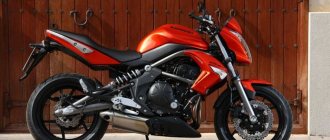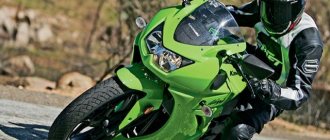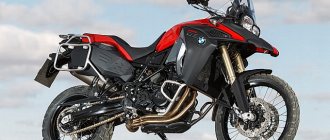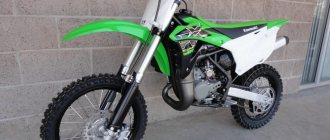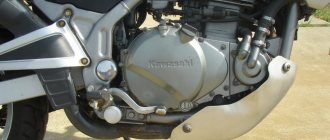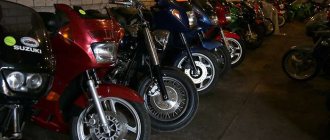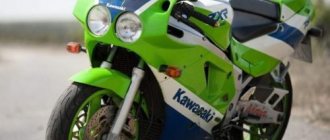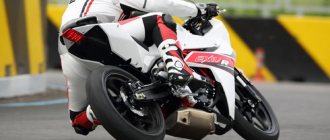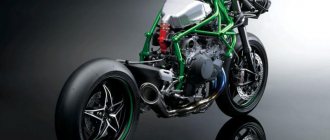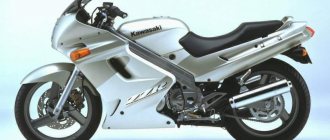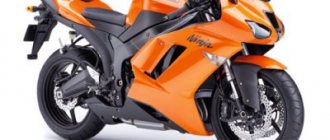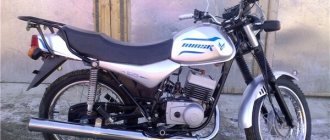This motorcycle is one of the versions of the Kawasaki ER-6 model. The bike has interesting properties. In terms of its class, this is a naked bike. Unlike the ER-6F, there is not as much plastic in its frame, and it is not as aerodynamic. The motorcycle is suitable for those who love cars of this class and adore semi-sports design.
Yes, its appearance has not only sporting features, but the shapes themselves are imbued with the aggression that is inherent specifically in sports motorcycles. So, if you like sports bikes purely in appearance, you might want to pay attention to this option.
Engine
The engine of the car is four-stroke, two-cylinder, in-line. Its working volume is 649 cubic centimeters. In just 3.8 seconds the bike can accelerate to 100 kilometers per hour. Its maximum speed is 200 kilometers per hour. This is possible thanks to the engine and its settings, which provide the following characteristics: maximum torque is 66 Newton meters at 7000 rpm, and maximum power is 72.1 horsepower at 8500 rpm.
Owner reviews
A good bike for every day and for all occasions, more than 40k km have already been wound on the wheels. During this time, the following were replaced: the clutch, seals and boots all around, the chain and sprockets (twice), the headlight on the face (replacement for tuning), and there were other little things, but there were no breakdowns at all. I drive my motorcycle both hard and fast, I service it strictly according to the manual, and don’t just change the oil, I’m confident in its reliability. An excellent motorcycle, clearly balanced, light, and very easy to steer. Anything more powerful is already much more expensive both in terms of purchase and maintenance, so the Kawasaki EP6 is the golden mean. Ilya, Moscow, Kawasaki ER 6N '2008
I've been happy with the motorcycle for three years now, I took it second-hand with a mileage of 17 thousand in the showroom, the mileage is similar to the truth, judging by indirect evidence. There was only one problem this entire time: it filled up with bad gasoline near Tver, the car started sneezing and twitching, only flushing the injector saved it, and I ended up driving a tow truck to get service. The ILO generally cannot digest low-quality gasoline; as soon as it does, it immediately begins to mope. Everything else is great. Alexander, St. Petersburg, Kawasaki ER 6N '2010
A normal moped for my money, when I was choosing, I looked at a bunch of options. I have no heart for Sabotage, and the Hornet, all other things being equal, will be more expensive than Yorshik, that’s why I took it. I skated the 2022 season, before that there was a season on Yobrik, now the bike is up for sale, I want a CB1000. The ruff gets boring over the course of a season, I want better dynamics and better brakes, but it will do for beginners. Arthur, Pskov, Kawasaki ER 6N '2015.
Dimensions and weight
The length of the motorcycle is 2100 millimeters. Its width reaches 760 millimeters. The height of the bike is 1095 millimeters. The seat height is 785 mm, and the wheelbase is 1405 mm. The curb weight of the motorcycle is 196 kilograms. The fuel tank capacity of the Kawasaki ER-6N is 15.5 liters.
Estimated cost
The price of the Kawasaki Er-6n motorcycle from official dealers starts at 6,300 euros.
The motorcycle version with the ABS system will cost more. This price is significantly lower than many competitors.
The Yamaha MT-07 will cost about 8,000 euros, and the Suzuki SFV650 Gladius or Ducati Monster 696 will cost 9,000 euros.
The Suzuki SV 400 S motorcycle model incorporated the most modern trends in the construction of motorcycles of its time.
This 400 cc motorcycle is positioned as a city bike - maneuverable, lightweight, with a good engine for its weight.
Chassis and brakes
The motorcycle frame is steel. It has a semi-sporty design because it is not particularly aerodynamic. The wheel rims are alloy and have a very aggressive look. The steering wheel is comfortable and looks very impressive, especially considering the striking shape of the mirrors.
The rear suspension of the motorcycle is pendulum, has a monoshock absorber, and its travel is 125 millimeters. The role of the front suspension is performed by a telescopic fork with dimensions of 41 millimeters, the travel of which is 120 millimeters.
Review of the Kawasaki ER-6 motorcycle (ER-6n, ER-6f, Ninja 650R)
It was unusual to drive on two cylinders. The engine is different - I’m used to four-cylinder ones. However, from the bottom it goes and spins. Landing for every day is not comfortable. Very quiet, anyone who has driven in traffic jams will understand. I don’t like a dashboard without tachometer needles. In traffic jams after the Suzuki it is very convenient - narrow and low. No trunk, bad. Probably it can be done. Overall, the impressions are positive. ABS would be better.
Hello everyone, I have owned this miracle technique for one season, during which time it has not let me down!!! In Moscow, driving through traffic jams is a pleasure, since it is relatively narrow, and it also behaves excellently on highways. At a speed of 150-160 you feel completely comfortable, but starting from 160-200 you ride lying on the tank. I have a bike with ABS, but because of this modification the bike costs a little more, but it’s worth it!!! After all, you never know when and where you will have to brake urgently (many people say that this is all bullshit and it would be easier for me to practice braking more often, starting from the line, or on an empty road. Here is the very nuance, yes, training is good and you are ready for it, but when this happens very suddenly, are you sure that you will have time to react and painlessly perform emergency braking?). So the bike is good both in urban conditions and on the highways, it is worth the money and will please both complete beginners and more experienced riders.
1. The overall appearance of the motorcycle does not evoke any conflicting emotions, ala sport, with good wind protection at 160 it does not blow away, unlike any other covers;
2. The classic seating position with a slight forward tilt and a low seat (with a height of 180 cm, I can not only reach the ground, but also my legs are quite strongly bent at the knees), when starting from a traffic light, I still don’t always end up on the left step and, accordingly, have difficulty engaging first gear (I think with time I got used to it and this problem will disappear) I also hit the bone of my left ankle when extending the side stand on the footrest;
3. All controls on the steering wheel are located intuitively, no getting used to is required;
4. The engine runs quite pleasantly (the sound as the speed increases pleases the ear), at a speed of 40-50 you can drive in top gear - all the merits of the 2-cylinder engine, on a single-barrel enduro it is simply impossible to move at the same pace in top gear; vibrations are not easy are unbearable, but can simply throw you out of the saddle))) so it’s better to switch down in time;
5. The gearbox works smoothly, there are no problems finding neutral, it’s just loud enough;
6. The dynamics are not much, but better than that of the enduro (after all, the difference in volume is small 600 versus 650 for the ERsha), the maximum power value is 30 hp, but the difference in torque is 5 Nm, the rev and maximum speed are in favor of the ERsha, and so the elasticity of the engine is much better, which is very helpful when starting from a traffic light (there is little chance of stalling);
7. The headlights are not very bright even though it costs bi-xenon.
I've driven it for about 2000 km so far. Sit comfortably and comfortably. You don’t slide off the seat (thanks to the fabric upholstery) even during sudden maneuvers. The motorcycle itself is narrow, but the handlebars are wide, wider than on a Yamaha. The mirrors are also located wider and, in my impressions, give a worse view than on the Phaser, I constantly adjust it to suit myself. In traffic jams they pass over cars, but can touch the mirrors of SUVs and gazelles. Due to the width of the steering wheel and mirrors, in traffic jams you have to slow down where you were flying before. The legs reach the entire foot to the ground, which gives a feeling of stability.
In general, despite the height of the seat, the bike itself is low. The first impression of all friends who saw him was “ahh, how small”!!! Then, after walking around for a couple of minutes and sitting on it, my opinion changes - “cool, how comfortable it is”!
The 2-cylinder engine produces vibrations both at idle and while driving. Compared to the Yamaha, it works smoothly and smoothly. Kava shakes like a small tractor. But it's cool, I like it)
Around 3-5 thousand revolutions, slight vibrations are felt on the footpegs and on the steering wheel. I stopped feeling the vibrations after a week; at the moment they don’t bother me at all. When I let off the gas, the engine itself intensively brakes the engine; sometimes I don’t even use the brakes, I just switch to lower gears. In addition, up to 3 thousand revolutions the engine is overly nervous and sharp; it happened to me that the rear wheel went into a skid when changing gears or when the clutch was suddenly released. I haven't seen anything like this with Yamaha.
In terms of acceleration to hundreds, the pickup is more intense than that of the Phaser; on YouTube they write that they managed to reach one hundred in 3.18. According to my impressions, yes, it accelerates faster due to torque, but up to 110-120, then the Phaser outperforms in terms of power. In addition, on the Phaser there was a kick in the ass from about 8-9 thousand rpm, but there is no such thing here. Everything is predictable and uniform. But the engine pulls from any gear and at any speed, you can immediately put it in 3rd and not feel any discomfort.
According to the computer, the average consumption is within 4.5 l/100 km (if you unscrew it, then 5.5). Since the peak torque occurs at 7 thousand revolutions, you can not overclock the engine and save gasoline.
The instrument panel, although small, is convenient, all readings can be read at one glance, the backlight is soft and non-irritating.
The gears are switched on even with a little effort (on the Phaser I remember you had to click your foot sharply), it is almost impossible to mix them up. In addition, if the motorcycle has stopped, you cannot immediately switch from 1st gear to 2nd, only to neutral. Comfortable.
Brakes. I have both the old one and the new one without ABS. Since the Phaser had R1 brakes, I had full control over deceleration and effectively stopped within inches of obstacles. Here you have to slow down in advance. The brakes grab decently, but there is no predictability and confidence, it seems that you are about to lock the wheel.
Light. The near light shines poorly, to put it mildly, but with the distant light the situation changes a little for the better. But you still need to change to xenon. Sound. The exhaust is quiet and slightly bassy. Reminds the work of a v-shape. I decided that I would change to Akropovich, I can’t hear it in traffic jams. Cooling. The fan works unusually hard even in cool weather. At first I thought it was defective, checked the entire cooling system, and asked the service center. It turned out that this is how the model was made, this is normal.
In general, the ergonomics are thought out, all the remote controls are in their place, you get to the right place the first time. I noticed that after 2-3 weeks of daily use, the paint began to slowly wear off from the frame (where the knees touch), as well as on the footrests. I decided to cover the frame with film, and I’ll have to ride like that with the footrests, I haven’t come up with anything yet...
To put it briefly, this is the most affordable Japanese to date from a number of 600 cc nakeds. In the city he is grabbed by the eyes and is one of the first to leave traffic lights. True, not for long)) Recently we started at the same time from a traffic light with an R6, and so they made me only in 3rd gear. The speed was about 130 km/h.
Because of its spectacular appearance, many people pay attention. Spare parts are inexpensive, service is also inexpensive (the first service from the officials costs 4800 including materials). The model is reliable, there are minimal electronics, there is nothing to break (I talked with the guys from the official services). In addition, this motorcycle is not suitable for fast riding. Yes, it can accelerate if necessary, but its element is calm driving at a cruising speed of 120-130 km/h, the engine does not provoke you to turn the handle to the limit, and I consider this a huge plus.
All the disadvantages that I described can be found in each device. These are not even disadvantages, but minor shortcomings, I’m really finding fault. In fact, the motorcycle is excellent, and I don’t regret buying it at all.
